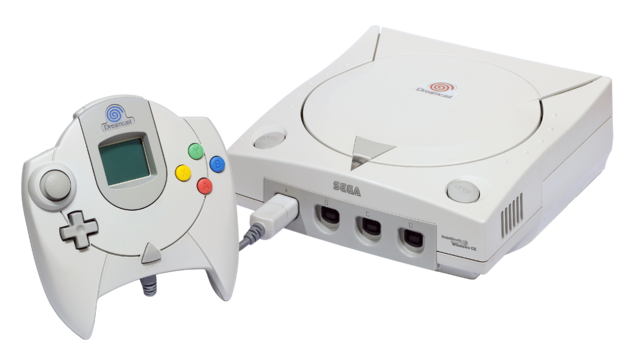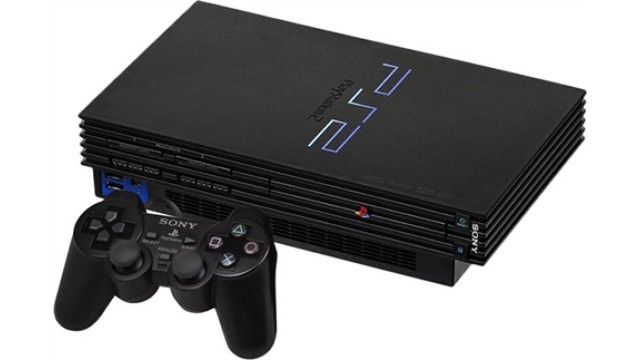
GameCube
Launches: 2001
Discontinued: 2007
Life span: 6 years
Units sold: 21 740 000
Generation: 6th
Country releases of GameCube
 Japan: Japan: | 14/Sep/2001 | ||
 USA: USA: | 18/Nov/2001 | 199 | $ |
 Australia: Australia: | 17/May/2002 |
 GameCube technical specifications
GameCube technical specifications
CPU: IBM PowerPC Gekko (32 bits)
Memory: 24 MB
 GameCube video specifications
GameCube video specifications
GameCube graphics capabilities.
Video chip: ATI Flipper
Video connection:
 GameCube audio specifications
GameCube audio specifications
GameCube sound capabilities.
Audio chip:
Audio mode:
 Controllers of GameCube
Controllers of GameCube

The standard GameCube controller has a wing grip design. This controller was included with all new GameCube systems throughout the console's lifecycle and was also available separately.
The standard GameCube controller provides haptic feedback through a built-in rumble engine. Rrather than using an external Rumble Pak add-on like the Nintendo 64 Controller. But, unlike its predecessor, it features no expandability.
The controller features a total of six digital buttons, two stepped analog sticks, a directional pad and two hybrid analog and digital triggers.

A wireless variant of the GameCube controller known as WaveBird was released in 2002.
 GameCube games support
GameCube games support
Support: DVD
For the GameCube, Nintendo stopped using cartridges as a means of distributing its games. Instead, Nintendo opted to use optical drives, creating the Nintendo Optical Disc format for this purpose. Using DVD technology in a Matsushita drive, the game is presented in the form of an optical disc with a storage capacity of 1.5 GB of information. In addition, the console's reader unit is capable of accessing the disc at a higher speed than a conventional DVD.
GameCube games
Games library: 600
In its lifetime from 2001 to 2007, more than 600 games were released for the GameCube. Nintendo released games from several of its first-party series on the Gamecube, such as the Super Mario and The Legend of Zelda series. Nintendo also created new franchises that debuted on the system, such as Pikmin and Animal Crossing and brought back series that skipped the Nintendo 64 platform, such as Metroid with the release of Metroid Prime. The console had several successful games such as The Legend of Zelda: The Wind Waker and Super Mario Sunshine and its best-selling game, Super Smash Bros. Melee, which sold 7 million copies worldwide. However Nintendo was criticized for not introducing enough games during the console's launch window, a sentiment exacerbated by the release of Luigi's Mansion instead of a 3D Mario game.
GameCube story
The Nintendo GameCube represents a pivotal moment in the history of Nintendo, as the company sought to regain its dominance in the gaming industry during the early 2000s. Following the success of the Nintendo 64, which introduced the world to 3D gaming with titles like Super Mario 64 and The Legend of Zelda: Ocarina of Time, Nintendo faced increasing competition from Sony’s PlayStation and, later, Microsoft’s Xbox. The gaming landscape was rapidly evolving, with a greater emphasis on graphical fidelity, online capabilities, and multimedia features. Nintendo’s response to these challenges was the GameCube, a console that aimed to combine powerful hardware with a focus on pure gaming experiences.
The creation of the GameCube began in the late 1990s, as Nintendo recognized the need to develop a new console that could compete with the emerging PlayStation 2 and the upcoming Xbox. Nintendo’s goal with the GameCube was to create a system that could deliver high-quality graphics and performance while maintaining a strong focus on gameplay. The company wanted to move away from the cartridge-based system of the Nintendo 64, which had limited storage capacity and was more expensive to produce, towards a more cost-effective and efficient medium. Thus, the GameCube was designed to utilize optical discs, a first for Nintendo, which allowed for greater storage capacity and lower production costs.
During the development of the GameCube, Nintendo collaborated with several key partners to ensure the console would be technologically competitive. The console’s hardware was developed with the assistance of IBM and ATI Technologies (now part of AMD). IBM provided the GameCube’s central processing unit, known as the Gekko, which was a custom-designed PowerPC-based chip. This CPU was designed to offer high performance and efficiency, enabling the GameCube to handle the complex graphics and physics calculations required for modern 3D games. ATI Technologies was responsible for the GameCube’s graphics processing unit, the Flipper, which provided the console with advanced graphical capabilities, including support for features like anti-aliasing and texture compression, which were important for delivering visually appealing games.
The decision to use a proprietary miniDVD format for the GameCube’s discs was another notable aspect of its development. These discs were smaller than the standard DVDs used by competitors, with a capacity of 1.5 GB. While this format helped reduce load times and piracy, it also had limitations in terms of storage space, which some developers found restrictive. Despite this, the miniDVD format allowed Nintendo to maintain control over the production and distribution of games, which was important for ensuring quality and preventing piracy.
Nintendo also focused on creating a console that was simple and accessible, both in terms of design and user experience. The GameCube’s design was distinctive, featuring a compact, cube-like shape with a handle for easy portability. This design was a deliberate choice by Nintendo, emphasizing the console’s focus on gaming rather than multimedia functions like DVD playback, which were becoming increasingly common in other consoles. The GameCube’s controller was also carefully designed to be comfortable and intuitive, with a button layout that was intended to be easy to learn for players of all skill levels.
The launch of the GameCube was a major event for Nintendo. The console was officially unveiled to the public at the SpaceWorld trade show in Japan in August 2000, where it was met with enthusiasm from fans and industry insiders alike. The GameCube was launched in Japan on September 14, 2001, followed by a North American release on November 18, 2001, and a European release in May 2002. Priced at $199, the GameCube was more affordable than both the PlayStation 2 and the Xbox, which was part of Nintendo’s strategy to attract a broad audience.
At launch, the GameCube was supported by a lineup of games that showcased its capabilities and catered to a wide range of players. One of the most important titles was Luigi’s Mansion, a game that featured Nintendo’s iconic character Luigi in his first starring role. This game highlighted the GameCube’s graphical power, with its detailed environments and lighting effects. Other notable launch titles included Super Smash Bros. Melee, which quickly became one of the best-selling games on the platform, and Wave Race: Blue Storm, which demonstrated the console’s ability to render realistic water effects.
Despite the strong launch lineup, the market reception of the GameCube was mixed. While the console was praised for its powerful hardware, unique design, and strong first-party titles, it struggled to gain the same level of market share as the PlayStation 2. One of the key challenges for the GameCube was the perception that it was primarily a console for younger audiences. This was partly due to Nintendo’s family-friendly image, but also because many of the GameCube’s early titles were aimed at younger players. In contrast, the PlayStation 2 had a more diverse library that appealed to both casual and hardcore gamers, including older teens and adults. This broader appeal helped Sony dominate the console market during this period.
Another issue that affected the GameCube’s market reception was its lack of third-party support. While Nintendo’s first-party games were consistently high quality, there were fewer third-party titles on the GameCube compared to its competitors. Many developers were hesitant to create games for the GameCube due to its unique miniDVD format and the perceived difficulty of developing for Nintendo’s hardware. Additionally, some major franchises that were popular on other platforms, such as Grand Theft Auto and Final Fantasy, were not available on the GameCube, which further limited its appeal to certain segments of the gaming audience.
Despite these challenges, the GameCube developed a dedicated fanbase and became known for its strong library of first-party titles. Over the course of its life cycle, the GameCube saw the release of several critically acclaimed games, including Metroid Prime, The Legend of Zelda: The Wind Waker, Super Mario Sunshine, and Pikmin. These games not only demonstrated Nintendo’s commitment to innovative and high-quality game design but also helped to maintain the GameCube’s relevance in a competitive market. Additionally, the GameCube was home to several unique and experimental titles, such as Animal Crossing and Eternal Darkness: Sanity’s Requiem, which helped to expand the range of experiences available on the console.
The GameCube also introduced several notable features that would influence future Nintendo consoles. For example, the GameCube’s connectivity with the Game Boy Advance allowed for cross-platform interaction, where players could use the handheld device as a secondary controller or to unlock additional content in certain games. This idea of cross-platform functionality would later be expanded upon with the Wii U and the Nintendo Switch.
In terms of sales, the GameCube ultimately lagged behind its competitors. By the end of its life cycle, the GameCube had sold approximately 21 million units worldwide, significantly less than the PlayStation 2, which became the best-selling console of all time with over 155 million units sold. The Xbox, despite being Microsoft’s first foray into the console market, also outsold the GameCube, with over 24 million units sold. These sales figures reflected the GameCube’s difficulties in appealing to a broad audience and competing with the more multimedia-focused and third-party-rich offerings from Sony and Microsoft.
The GameCube’s market performance had a profound impact on Nintendo, prompting the company to reassess its strategy for future consoles. While the GameCube was a commercial disappointment compared to Nintendo’s previous consoles, it also served as a valuable learning experience. The lessons learned from the GameCube’s struggles would inform the development of the Wii, a console that would prioritize innovation and accessibility, leading to one of the most successful periods in Nintendo’s history.
In retrospect, the Nintendo GameCube is remembered as a console that offered some of the most beloved and enduring games of its generation, despite its commercial challenges. The console’s focus on pure gaming experiences, its distinctive design, and its strong library of first-party titles have earned it a lasting legacy among fans and collectors. The GameCube is also seen as a symbol of Nintendo’s commitment to innovation and creativity, even in the face of intense competition. While it may not have achieved the same level of success as some of its predecessors or successors, the GameCube remains an important part of Nintendo’s history and a testament to the company’s willingness to take risks and push the boundaries of gaming.
Previous Nintendo console: Nintendo 64
Next Nintendo console: Wii


